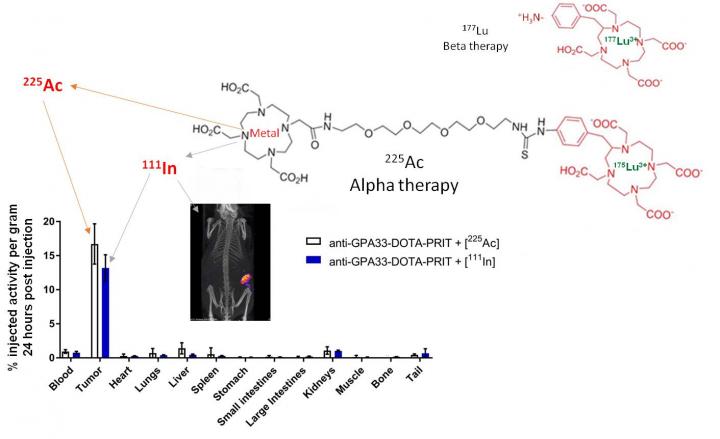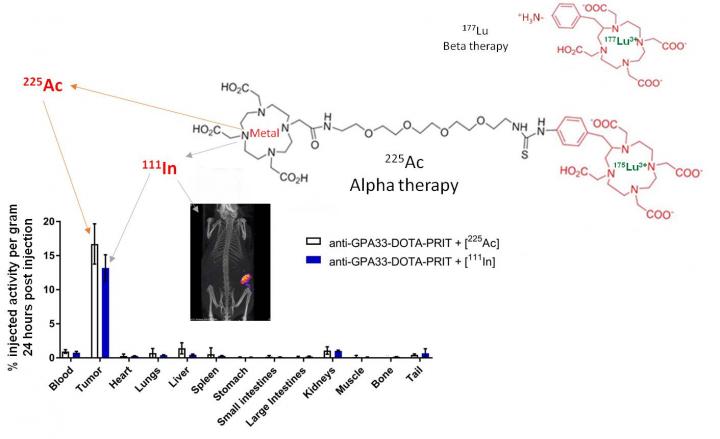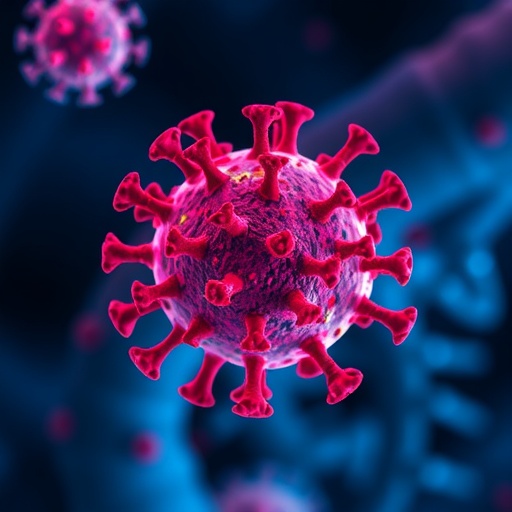
Credit: SM Cheal et al., Memorial Sloan Kettering Cancer Center, New York, NY.
PHILADELPHIA – A novel nuclear medicine approach is showing great promise for precision treatment of solid tumors in many types of cancer–including lung, breast, pancreas and ovarian in adults and glioma, neuroblastoma and sarcoma in children. The research was presented today at the SNMMI 2018 Annual Meeting, June 23-26 in Philadelphia.
In 2017, researchers from Memorial Sloan Kettering Cancer Center developed a novel approach to pretargeted radioimmunotherapy (DOTA-PRIT) that demonstrated preclinically, complete responses, including cures, in several solid tumor types using the beta-emitting lutetium-177 (177Lu)-DOTA-hapten. In the research presented today, the researchers expanded the DOTA-PRIT approach to actinium-225 (225Ac), an alpha-emitting isotope.
"Targeted alpha radiotherapy has shown considerable promise for patients, especially for those with advanced castration-resistance prostate cancer," said Steven M Larson, MD and Sarah M. Cheal, PhD, of the Program in Molecular Pharmacology and Department of Radiology at Memorial Sloan Kettering Cancer Center in New York. "By combining DOTA-PRIT with 225Ac-proteus-DOTA hapten, we can potentially target a wide array of cancer types for which we have validated DOTA-PRIT bispecific antibodies (GD2-expressing, HER2-expressing, and GPA33-expressing cancers)."
DOTA-PRIT has a major advantage over other forms of radioimmunotherapy because of its very high ability to deliver radiation to tumors while sparing normal tissues, such as kidney and bone marrow. Larson and Cheal explained, "Creating a targeting alpha radiohapten greatly expands the potential for killing small nests of cells and even single cancer cells, which is likely to be important early in the course of metastatic spread."
Researchers synthesized proteus-DOTA, radiolabeled it with 225Ac, and conducted in vitro and in vivo studies of a mouse model with colorectal cancer to determine if pretargeting the tumor with 225c-proteus-DOTA hapten was feasible. A toxicity study was performed in normal tumor-free athymic nude mice with varying dose levels of 225Ac-proteus-DOTA given as a single intravenous injection. Mice were monitored daily for 145 days post-injection and weighed up to twice weekly for evidence of treatment-induced toxicity.
Researchers found that their new approach, 225Ac-proteus-DOTA, mimics the behavior of the previously developed approach, 177Lu-DOTA-hapten, with high tumor uptake, minimal accumulation in normal tissue, good whole-body clearance, no acute toxicity and no chronic radiation damage (see figure below). In addition, the new approach offers greater versatility of treatment for a wide variety of solid tumors and clinical situations.
Larson and Cheal pointed out, "When solid tumors spread beyond surgical control, they are the deadliest tumors for cancer patients. Using the DOTA-PRIT approach, we hope to greatly expand the potential of delivering precision radioimmunotherapy to human solid tumors."
Scientific Paper 123: "Pretargeted radioimmunotherapy with 225Ac-proteus-DOTA hapten," Sarah M. Cheal and Miteshkumar V. Patel, Program in Molecular Pharmacology; Michael R. McDevitt and Steven M. Larson, Radiology; Guangbin Yang and Ouathek Ouerfelli, Organic Synthesis Core Facility; NagaVaraKishore Pillarsetty, Radiochemistry and Imaging Sciences Service; Hong Xu, Hong-fen Guo, and Nai-Kong Cheung, Pediatrics; and Edward K. Fung, Medical Physics, Memorial Sloan Kettering Cancer Center, New York, NY. SNMMI 2018 Annual Meeting, June 23-26, 2018, Philadelphia.
Link to Abstract
Research support for this study: The Center for Targeted Radioimmunotherapy and Diagnosis, Ludwig Center for Cancer Immunotherapy, Mr. William H. Goodwin and Mrs. Alice Goodwin and the Commonwealth Foundation for Cancer Research and The Experimental Therapeutics Center, MSKCC, Kids Walk for Kids with Cancer NYC, and the Robert Steel Foundation.
###
Please visit the SNMMI Media Center for more information about molecular imaging and personalized medicine. To schedule an interview with the researchers, please contact Laurie Callahan at 703-652-6773 or [email protected]. 2018 SNMMI Annual Meeting abstracts can be found online at http://jnm.snmjournals.org/content/59/supplement_1. Current and past issues of The Journal of Nuclear Medicine are online at http://jnm.snmjournals.org.
ABOUT THE SOCIETY OF NUCLEAR MEDICINE AND MOLECULAR IMAGING
The Society of Nuclear Medicine and Molecular Imaging (SNMMI) is an international scientific and medical organization dedicated to advancing nuclear medicine and molecular imaging, vital elements of precision medicine that allow diagnosis and treatment to be tailored to individual patients in order to achieve the best possible outcomes.
SNMMI's more than 16,000 members set the standard for molecular imaging and nuclear medicine practice by creating guidelines, sharing information through journals and meetings and leading advocacy on key issues that affect molecular imaging and therapy research and practice. For more information, visit http://www.snmmi.org.
Media Contact
Laurie F Callahan
[email protected]
@SNM_MI
http://www.snm.org
Original Source
http://www.snmmi.org/NewsPublications/NewsDetail.aspx?ItemNumber=29465





